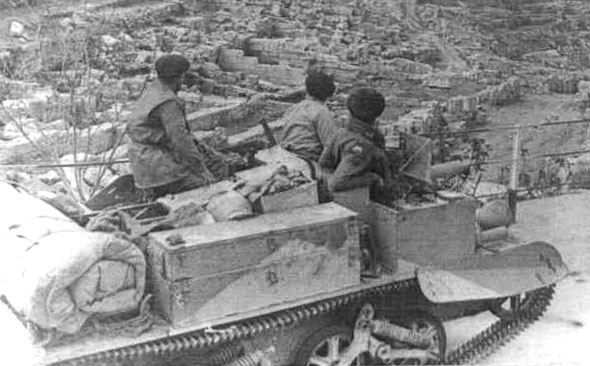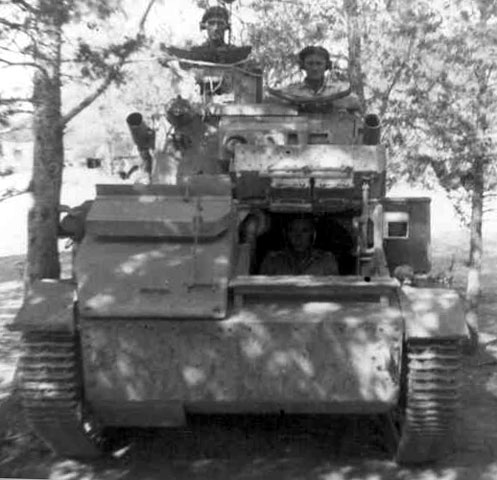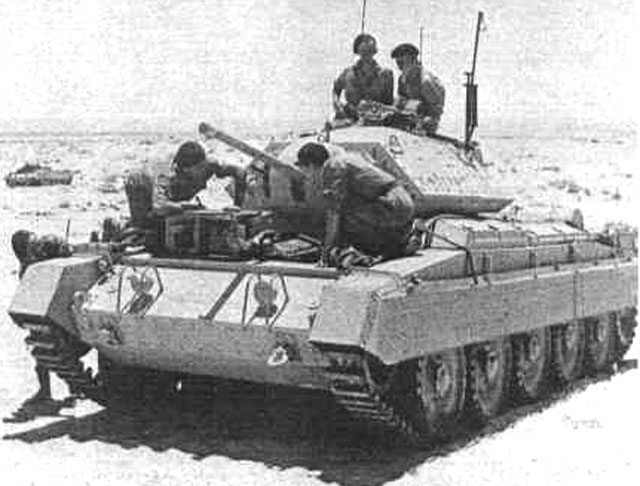![]()
Australian Armour in the Middle East, 1940-1942
by Paul D. Handel
|
|
|
| A Universal Carrier Mark 1 of 6th Division Cavalry in February 1941. The armament is a Boys Anti-tank rifle and a radio set is fitted to the Carrier. The crew wear Australian Pattern service Dress dating from WW1 with black berets. The Divisional sign is seen on the left front mudguard. |
Some Australian LP1 carriers were also on issue, characterised by their
truck headlights, double stowage bin on the right and long stowage tray at
the rear (see title pjoto). It appears that some of these may have been
finished in the Caunter scheme.
Returning to Helwan in April 1941, the Regiment was equipped with Vickers
Light tanks Mark VIB and Machine Gun Carriers of various types, and
operated with the British up to the capture of Sollum. Towards the end of
May 1941, the Regiment moved to northern Palestine under command of the
7th Australian Division, where preparations were in progress for an
invasion of Syria, then held by Vichy French Forces.
The rugged hills along the coast rose sharply from the road, leaving
little room for the manoeuvre of the tanks and carriers. At one stage, the
Tank Troops were communicating with naval ships off the coast using
signalling flags, and were able to target advancing French armoured
vehicles.
Whilst undergoing a rest period, A Squadron had taken over and got ready
for action three captured French R35 Renault Light Tanks. These tanks,
although slower than the Vickers Lights, were much more heavily armoured.
B Squadron also received three R35 tanks and both squadrons used them
during subsequent patrolling activities. The Renaults appear to be in a
dark colour, possibly a dark green.
The fight for the town of Damour, beginning on 6 July 1941, was one of the
most difficult of the entire Syrian Campaign. The Cavalry did not play a
major role in the battle, although a captured French R35 Renault tank
being used by the Regiment was destroyed by a French 75mm gun.
![]()
7th Australian Division Cavalry Regiment
Arriving in Palestine in February 1941 the Regiment conducted training in
desert conditions. During April 1941, a cavalry regiment was required to
go in the desert, and of the two available cavalry regiments, the 6th
Division Cavalry had much experience in desert warfare but was
under-equipped and the 7th Division Cavalry had equipment but no
experience. On the toss of a coin the 6th Division Cavalry won and the 7th
Division Cavalry handed over their equipment and moved to stations along
the Suez Canal.
In May 1941 the Regiment was sent to Cyprus to defend against the likely
German invasion. Equipped with Vickers Light Tanks, Carriers, and trucks
fitted with 2pdr Anti-Tank Guns, the Regiment served in this role until
its move to Syria. The full story of this episode is in
another article on this site entitled
“Australian Armour On Cyprus”. It was sent to Syria to rejoin its
Division in August 1941.
|
|
|
A Vickers Light Tank Mark VIB of 7th Division Cavalry Regiment in Syria. No markings are evident on this vehicle. |
In Syria it took over other Australian equipment, including very well used
Vickers Light Tanks Mark VIB, Universal carriers and Renault R35 tanks.
![]()
9th Australian Division Cavalry Regiment
Shortly after their arrival in Palestine in mid 1941 the unit was
warned out to participate in the forthcoming Syrian campaign. Because the
unit had already done armoured training in Australia, and were probably
the best prepared of the Divisional Cavalry Regiments at the time of
embarkation, the short time between arrival and being committed into
action did not appear to be a problem.
As with the other regiments, the 9th Division Cavalry Regiment were
equipped with Vickers Light Tanks Mark VIB and various types of Machine
Gun Carriers. Contact was first made with the Vichy French Forces at
Jezzine on 14 June 1941. The unit acquired some Vichy French Renault R35
tanks, small but heavily armoured, and these were take into action at
Barada Gorge. Some of the carriers carried the Divisional sign, an
Platypus
over a boomerang, along with the unit sign.
|
|
| A Vickers Light Tank Mark VIB of 9th Division Cavalry Regiment after the Syrian campaign. This vehicle displays the unit and divisional signs and a spare roadwheel is carried on the side of the turret. |
At the completion of the Syrian Campaign, the Regiment returned to
Palestine for rest and re-training. In January 1942 they were moved back
to Syria, engaging in reconnaissance work and patrolling of northern
Syria. The 9th Division Cavalry was sent to Egypt after the German
advances in July 1942, accompanying their parent formation.
Here, for the first time in the Middle East campaign, an Australian
Cavalry Regiment was equipped with modern armour, in the form of British
Crusader Mark 2 Cruiser tanks, M3 Stuart Light tanks as well as the
ubiquitous Machine Gun Carriers. They provided two squadrons for the
protection of the Headquarters of the 9th Australian Division, becoming
involved in several tank versus tank engagements. During these actions
several Universal Carriers were destroyed and some Crusaders were damaged.
|
|
| The crew of a Crusader tank of 9th Division Cavalry Regiment working on their vehicle prior to El Alamein. The tank is relatively “clean”, with little stowage evident. |
At the time of the battle of El Alamein in October 1942, the Regiment had
on strength 5 M3 Stuart Light Tanks, 15 Crusader Mk 2 Cruiser Tanks and 52
Universal Carriers. The Cavalry did not play a major role during the
battles of Alamein, being held in divisional reserve. In early November
the regiment was chosen as the advance guard to lead the division in the
westward advance. The Eighth Army's advance, however, was too fast, and as
the 9th Division was being withdrawn to serve in South West Pacific
theatre, the Cavalry did not take part in the pursuit of the Afrika Korps.
No photographic evidence has yet been found of the Crusaders and Stuarts
carrying Australian unit or divisional signs. Most appear to have the
British T number on the left front of the turret.
![]()
Sources
Each of the Division Cavalry Regiments produced their own form of
history, all now out-of-print. For the researcher and modeller, the
starting point for vehicle photos should be the Photographic Database of
the Australian War Memorial (
www.awm.gov.au ). There are many photos of each of the regiments
during their service in the Middle East and later in Australia.
The photos in this article are from the Author’s own files, contemporary
journals, soldiers’ own photos or the relevant Regimental History.
A recent book by this author was published by the RAAC Memorial and Army
Tank Museum. Entitled DUST, SAND and JUNGLE - A History of Australian
Armour 1927 to 1948, it tells the story of Australian Armour during
training and operations from 1927 to 1948. It includes details of the
formation of the Corps and the School, training and operations, unit
histories and vehicle developments.
Its title reflects the many locations in which Australian armour trained
and fought – the dust of Puckapunyal, Singleton, Narrabri and Western
Australia; the sand of the Middle East, although much of the action took
place in the mountainous terrain of Syria; and the jungles of the Pacific,
where Australian armour achieved so much.
This hardback book of over 210 pages contains 95 illustrations, 6 maps and
8 scale drawings. The recommended retail price is AUD$40.00 plus postage.
It can be obtained from the RAAC Memorial and Army Tank Museum, Hopkins
Barracks, Puckapunyal, Victoria 3662, Australia. Telephone is (03) 5735
7285 and Fax (03) 57931735, Email address is
atm@ancc.com.au .
A
review of this book is contained on the Hyperscale site.
![]()
Australian Armour in the Middle East PHOTO ALBUM
Click
the thumbnails in the table below to view the images full size.
Use your browser's "back" arrow to return to this page.
![]()
Article Text and Photographs Copyright ©
2003 by Paul D.
Handel
Page Created 25 April, 2003
Last Updated 25 April, 2003
Back to Anzac Steel Main Page









